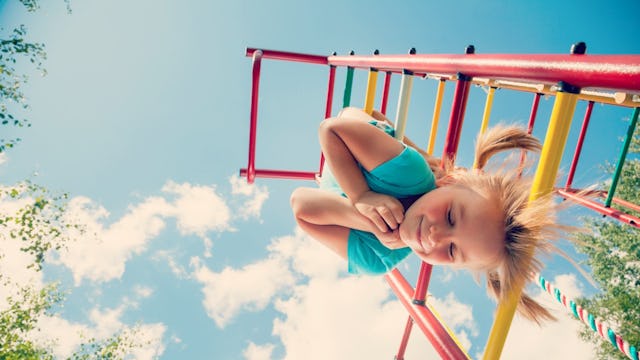Have a Sensory Kiddo? Help Them Calm Down By Hanging Upside Down

Hanging upside down stimulates our vestibular system. But, what is that? To be brief, our vestibular system is in our inner ear. This sensory system is responsible for our sense of balance, spatial orientation (knowing where our bodies are in the world), and coordinating our balance with movement. Every movement we make stimulates our vestibular system. If your child exhibits vestibular seeking behaviours, then planned sensory activities that involve hanging upside down (inverting the head) can provide him with the stimulation he needs and reduce sensory seeking throughout the day as well as dysregulation and sensory-related meltdowns.
RELATED: 15 Ways To Calm Down When You’re Stressed, Overwhelmed, Or Anxious
Vestibular Seeking Behaviors
These behaviors may include:
– Inability to sit still
– Hyperactivity — Needs to be in constant motion
– Impulsive actions
– Moving Quickly – Running, jumping, spinning
– Rambunctious play/ rough housing
– Constantly sitting in unusual positions on couch or chair (upside down, side ways, feet against the wall, etc.)
All of the above can happen within a 5 minute span at my house. All that, and more, is the chaos that I call my living room. Am I the only mom who has to put the cushions back on the couch 20 times a day?
Kids (like mine) who excessively seek vestibular input can have it seriously interfere with their functioning on a daily basis. They likely appear to be in constant motion. The good thing is there are certain activities that can provide a powerful dose of sensory input which can have effects that last for hours. Plan to do these activities with your kids for a few minutes periodically throughout the day.
Hanging Upside Down
My children hang upside down off the couch all the time. There are some serious sensory benefits to inverting the head. In fact, we could all benefit from hanging upside down for short increments during the day. It helps to regulate and organize our nervous system. The unique experience stimulates the vestibular system, and the positive effects can be long lasting. It can actually be calming or alerting, depending on his current state of regulation, making it helpful when a child is recovering from a sensory meltdown.
Activities That Involve Hanging Upside Down
There are a lot of different ways you can fit inverting the head into regular play with your kids. Here are some ideas to get you started:
– Hanging from the couch
– Children’s yoga
– Hanging from the monkey bars
– For younger children, you can sit them on your lap facing you and hold their hands while you let them drop back upside down over your knees, and then pull them back up
– Lean backwards over a large exercise ball
– Gymnastics
Other Activities
Being upside down is not the only thing that stimulates the vestibular system – although it is one of the most effective. Other activities and games you can play throughout the day include:
– freeze dance (one of our favorites) – everybody dances really fast to the music and then when the song pauses you freeze no matter what silly position you were in
– Riding a bike
– Playing on the swings and slides
– Swimming
– Rhythmic bouncing or rocking on your lap
– Jumping on trampolines
– Pulling your child around the house on a blanket
– Playing ring-around-the-rosie
– Basically anything that involves moving your body, especially your head
We went to the park on the weekend and rolled down the hill over and over. The kids had a blast and it was the calmest, most well behaved they have been in ages.
[Note on Spinning: Spinning is another stimulating activity. Just remember, the way your child spins can have different effects on his state of regulation. Calm, slow and steady spinning in a single direction can be calming for him. But fast spinning, jolting around, can be stimulating and lead to hyperactivities or dysregulation.]
This article was originally published on